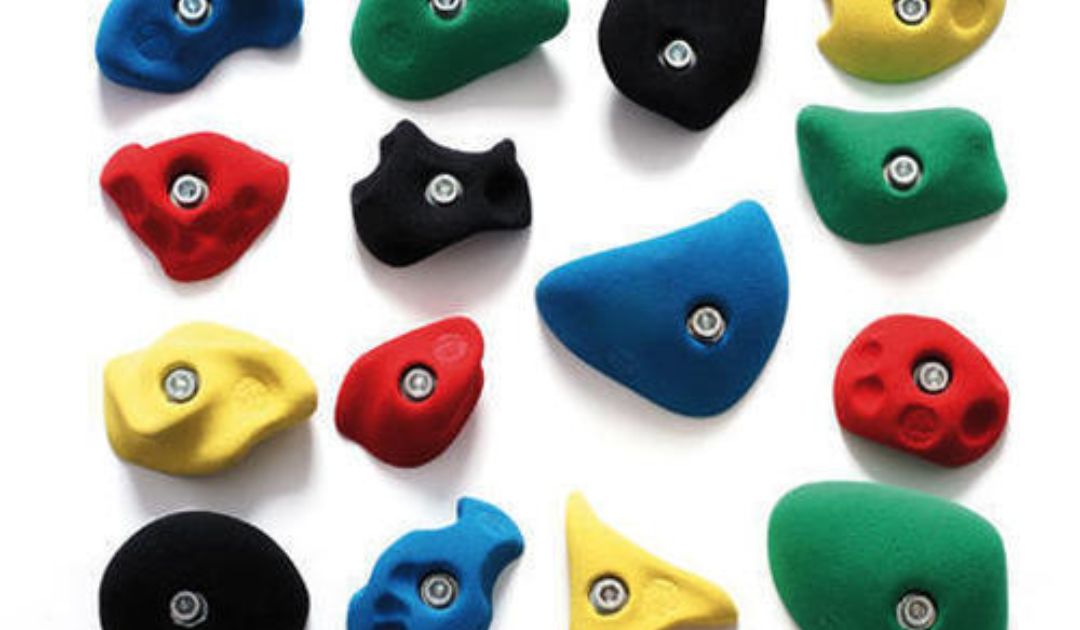Have you ever wondered what lies beneath your fingertips as you conquer towering rock walls? Delve into the world of rock climbing holds and uncover the materials that empower climbers to reach new heights. From the sturdy embrace of plastic and wooden holds to the resilient grip of fiberglass and polyurethane, this article explores the diverse array of materials used to create these essential tools for climbers. Join us as we unravel the secrets behind the construction of these vital components of the rock climbing experience.
Key Takeaways
- Plastic holds are durable and lightweight, allowing for easy replacement and rearrangement.
- Wooden holds provide a natural and organic feel, requiring grip strength and offering customization options.
- Fiberglass holds mimic the texture of natural rock and are resistant to weathering and UV damage.
- Polyurethane holds are durable, have a lower environmental impact, and provide reliable grip.
Plastic Holds
Plastic holds are commonly made of durable and lightweight materials, such as polyurethane or polyester resin. These synthetic materials offer several advantages when used in indoor climbing gyms. Firstly, plastic holds are highly versatile and can be molded into various shapes, allowing for a wide range of climbing routes to be created. This versatility ensures that climbers of different skill levels can find suitable challenges. Additionally, plastic holds can be easily replaced or rearranged, enabling route setters to constantly refresh the climbing experience. Moreover, the texture of plastic plays a significant role in the climbing experience. Different textures, such as smooth, rough, or textured patterns, can greatly impact the difficulty and grip of a climbing hold. This allows route setters to create diverse and engaging routes, catering to climbers’ preferences and skill levels.
Wooden Holds
Wooden holds, on the other hand, offer a different climbing experience compared to plastic holds due to their unique characteristics and construction. Here are some benefits of using wooden holds for indoor rock climbing:
- Realistic texture: Wooden holds provide a more natural and organic feel, mimicking the texture of real rock. This enhances the authenticity of indoor climbing.
- Improved grip strength: Wooden holds require climbers to engage their grip strength more intensely, helping to develop stronger fingers and forearms.
- Versatility: Wooden holds can be easily customized and shaped to create a variety of challenging holds and routes, allowing for endless possibilities in indoor climbing.
- Durability: With proper maintenance and care, wooden holds can last for a long time, making them a cost-effective investment for climbing gyms.
To maintain and care for wooden rock climbing holds, it is essential to regularly inspect and clean them, avoid excessive moisture exposure, and periodically sand and seal the holds to ensure their longevity and safety.
Fiberglass Holds
Fiberglass holds offer a unique climbing experience with their durable and lightweight construction. Made from a combination of woven fiberglass cloth and polyester resin, these holds are designed to withstand the demands of rock climbing while providing a comfortable grip.
One of the main advantages of fiberglass holds over other materials is their ability to mimic the texture of natural rock, allowing climbers to practice their skills on a variety of surfaces. Additionally, fiberglass holds are resistant to weathering and UV damage, making them ideal for outdoor climbing.
To ensure the longevity of fiberglass holds, proper maintenance and care are essential. It is important to regularly clean the holds with a mild detergent and water to remove dirt and sweat. Inspecting the holds for any signs of wear or damage is also crucial, as any cracks or breaks should be repaired or replaced immediately to prevent accidents. By following these maintenance and care tips, climbers can enjoy the benefits of fiberglass holds for years to come.
| Advantages of Fiberglass Holds | Maintenance and Care Tips for Fiberglass Holds |
|---|---|
| Mimic the texture of natural rock | Regularly clean holds with mild detergent and water |
| Durable and lightweight | Inspect for signs of wear or damage |
| Weather-resistant and UV-resistant | Repair or replace any cracks or breaks |
| Suitable for outdoor climbing |
Polyurethane Holds
Crafted from a durable and versatile material, polyurethane holds provide climbers with a reliable and adaptable grip during their rock climbing endeavors. Here are some key points about polyurethane holds:
- Durability and texture: Polyurethane holds are known for their long-lasting nature, making them ideal for high-traffic climbing areas. The material is resistant to wear and tear, ensuring that climbers can rely on these holds for a long time. Additionally, the texture of polyurethane holds is designed to simulate the feel of natural rock, providing a realistic and challenging climbing experience.
- Environmental impact: Compared to other materials used for climbing holds, such as fiberglass, polyurethane has a lower environmental impact. Polyurethane can be recycled, reducing waste and minimizing the carbon footprint associated with manufacturing and disposing of climbing holds.
Composite Holds
Composite holds are a popular choice for rock climbers due to their unique construction and versatility. These holds are made from a combination of materials, typically using a reinforced composite material that includes fiberglass and resin. The addition of fiberglass provides strength and durability, allowing the holds to withstand the constant use and pressure exerted during climbing. The resin helps to bind the composite materials together, creating a solid and stable surface for climbers to grip.
One of the advantages of composite holds is their environmental impact. Unlike some other materials used in climbing holds, composite holds are often made from recycled materials, reducing the need for new resources and minimizing waste. Additionally, the manufacturing process for composite holds is generally less energy-intensive compared to other materials, further reducing the environmental footprint. This makes composite holds a sustainable and environmentally friendly choice for climbers.
Frequently Asked Questions
Are There Any Safety Precautions or Guidelines to Consider When Using Rock Climbing Holds, Regardless of the Material They Are Made Of?
Safety precautions and proper usage are essential when using rock climbing holds, regardless of their material composition. Climbers should always inspect holds for cracks or damage, use proper climbing techniques, and ensure a secure and controlled grip to minimize the risk of accidents.
How Often Do Rock Climbing Holds Need to Be Replaced, and What Signs Should Climbers Look for to Determine if a Hold Is Worn Out or Damaged?
Rock climbing holds have a limited lifespan due to wear and tear. Climbers should regularly inspect holds for signs of damage or deterioration, such as cracks, chips, or excessive wear. Proper maintenance, cleaning, and customization can extend their lifespan. Consider environmental impact and follow safety guidelines.
Can Rock Climbing Holds Be Customized or Modified to Suit a Specific Climbing Route or Difficulty Level?
Rock climbing holds can be customized or modified to suit specific climbing routes or difficulty levels. This allows climbers to create unique challenges and test their skills. However, it’s important to consider the impact on climbing technique when making these modifications.
Are There Any Environmental Concerns Associated With the Production or Disposal of Rock Climbing Holds, Particularly Those Made From Materials Like Plastic or Fiberglass?
The production and disposal of rock climbing holds made from materials like plastic or fiberglass can have environmental impacts. It is important to consider recycling options and sustainable practices to minimize these concerns.
Are There Any Special Considerations for Cleaning or Maintaining Rock Climbing Holds, Depending on the Material They Are Made Of?
Cleaning and maintaining rock climbing holds requires special considerations depending on the material. Proper cleaning techniques, such as using mild soap and water, can help preserve the integrity of the holds. Regular inspections and maintenance ensure optimal performance and safety.
Conclusion
In conclusion, rock climbing holds are made of various materials such as plastic, wood, fiberglass, polyurethane, and composite. These materials are carefully chosen for their durability, texture, and ability to mimic natural rock surfaces. The use of different materials allows climbers to experience a variety of challenging and realistic climbing conditions. So next time you’re scaling a wall, remember to appreciate the irony that the holds which help you conquer the heights are themselves made to imitate the very thing you conquer.










